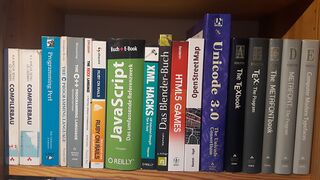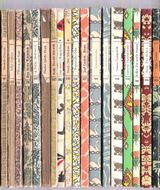SpineLib: Difference between revisions
Jump to navigation
Jump to search
imported>Gfis Created page with "320px|right 320px|right ==Library Management Using Images of Book Spines==" |
imported>Gfis No edit summary |
||
| Line 1: | Line 1: | ||
[[File:Bookshelf.jpg|320px | [[File:Bookshelf.jpg|320px]] [[File:2017-06-20 vert.jpg|160px]] | ||
[[File:2017-06-20 vert.jpg| | |||
==Library Management Using Images of Book Spines== | ==Library Management Using Images of Book Spines== | ||
===Situation=== | |||
Cataloging of the books a in private library with a few thousand books is much work, and usually it is not done. | |||
* ISBN barcode scanning could work in principle, but still each book must be taken from the shelf. Only newer books have ISBN barcodes. | |||
* Google, Amazon and also community projects like [https://www.librarything.com/ LibraryThing] provide images of book titles, but who is willing to photograph each book front? | |||
===Proposal=== | |||
This project proposes the recognition of books from their spines. | |||
* Photos from book shelves like the ones above are sliced into individual spine images. | |||
* The images are analyzed for color zones, publisher logo, author and title text. | |||
* Such data are looked up in a big database for known books. | |||
* Even if there is no exact match, the system could propose a small set of possible books, from which the librarian could select teh right book manually. | |||
===Advantages=== | |||
* Photographing of complete book shelves can be done rather easily and quickly in a large scale. | |||
* The system would be applicable to book stores for inventory purposes. | |||
* Even public and university libraries could use it for protection against the misplacement of books in reading rooms. | |||
===Problems=== | |||
* The book spine images are coyprighted by the publishers. | |||
* OCR of the titles and authors will be difficult because of many different fonts and languages. | |||
Revision as of 17:59, 18 July 2017
Library Management Using Images of Book Spines
Situation
Cataloging of the books a in private library with a few thousand books is much work, and usually it is not done.
- ISBN barcode scanning could work in principle, but still each book must be taken from the shelf. Only newer books have ISBN barcodes.
- Google, Amazon and also community projects like LibraryThing provide images of book titles, but who is willing to photograph each book front?
Proposal
This project proposes the recognition of books from their spines.
- Photos from book shelves like the ones above are sliced into individual spine images.
- The images are analyzed for color zones, publisher logo, author and title text.
- Such data are looked up in a big database for known books.
- Even if there is no exact match, the system could propose a small set of possible books, from which the librarian could select teh right book manually.
Advantages
- Photographing of complete book shelves can be done rather easily and quickly in a large scale.
- The system would be applicable to book stores for inventory purposes.
- Even public and university libraries could use it for protection against the misplacement of books in reading rooms.
Problems
- The book spine images are coyprighted by the publishers.
- OCR of the titles and authors will be difficult because of many different fonts and languages.

